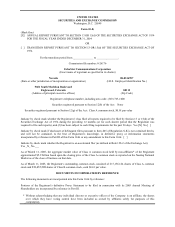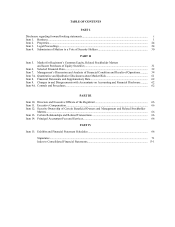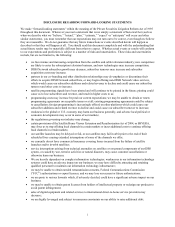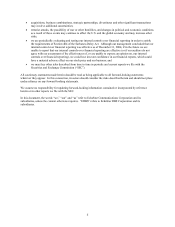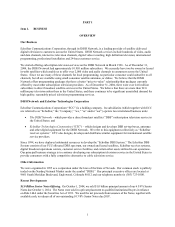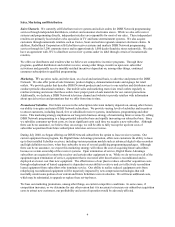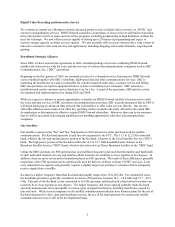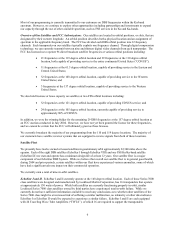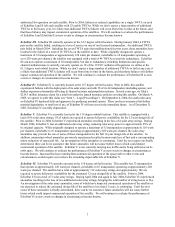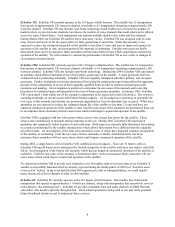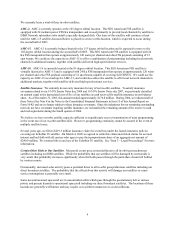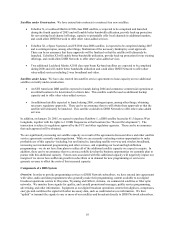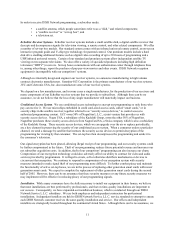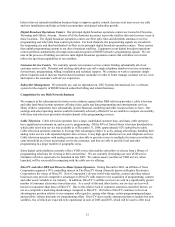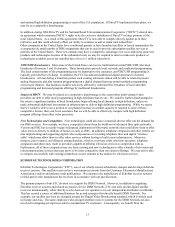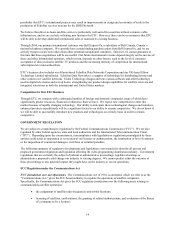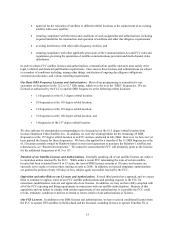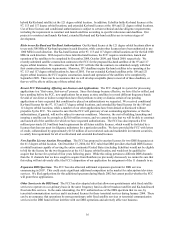Dish Network 2004 Annual Report Download - page 14
Download and view the complete annual report
Please find page 14 of the 2004 Dish Network annual report below. You can navigate through the pages in the report by either clicking on the pages listed below, or by using the keyword search tool below to find specific information within the annual report.6
Most of our programming is currently transmitted to our customers on DBS frequencies within the Ku-band
spectrum. However, we continue to explore other opportunities including partnerships and investments to expand
our capacity through the use of other available spectrum, such as FSS services in the Ku and Ka-bands.
Overview of Our Satellites and FCC Authorizations. Our satellites are located in orbital positions, or slots, that are
designated by their western longitude. An orbital position describes both a physical location and an assignment of
spectrum in the applicable frequency band. The FCC has divided each DBS orbital position into 32 frequency
channels. Each transponder on our satellites typically exploits one frequency channel. Through digital compression
technology, we can currently transmit between nine and thirteen digital video channels from each transponder. The
FCC has licensed us to operate 96 direct broadcast satellite frequencies at various orbital positions including:
• 21 frequencies at the 119 degree orbital location and 29 frequencies at the 110 degree orbital
location, both capable of providing service to the entire continental United States (“CONUS”);
• 11 frequencies at the 61.5 degree orbital location, capable of providing service to the Eastern and
Central United States;
• 32 frequencies at the 148 degree orbital location, capable of providing service to the Western
United States; and
• 3 frequencies at the 157 degree orbital location, capable of providing service to the Western
United States.
We also hold licenses or lease capacity on satellites at two FSS orbital locations including:
• 32 frequencies at the 121 degree orbital location, capable of providing CONUS service; and
• 24 frequencies at the 105 degree orbital location, currently capable of providing service to
approximately 80% of CONUS.
In addition, we were the winning bidder for the remaining 29 DBS frequencies at the 157 degree orbital location at
an FCC auction conducted in July 2004. However, we have not yet been granted the license for these frequencies,
and we cannot be certain that the FCC will ultimately grant us these licenses.
We currently broadcast the majority of our programming from the 110 and 119 degree locations. The majority of
our customers have satellite receiver systems that are equipped to receive signals from both of these locations.
Satellite Fleet
We presently have twelve owned or leased satellites in geostationary orbit approximately 22,300 miles above the
equator. Each of the eight DBS satellites (EchoStar I through EchoStar VIII) and one FSS Ku/Ka-band satellite
(EchoStar IX) we own and operate has a minimum design life of at least 12 years. Our satellite fleet is a major
component of our EchoStar DBS System. While we believe that overall our satellite fleet is in general good health,
during 2004 and prior periods, certain satellites within our fleet have experienced various anomalies, some of which
have had a significant adverse impact on their commercial operation.
We currently own a total of nine in-orbit satellites.
EchoStar I and II. EchoStar I and II currently operate at the 148 degree orbital location. Each of these Series 7000
class satellites were designed and manufactured by Lockheed Martin Corporation, has 16 transponders that operate
at approximately 130 watts of power. While both satellites are currently functioning properly in orbit, similar
Lockheed Series 7000 class satellites owned by third parties have experienced total in-orbit failure. While we
currently do not have sufficient information available to reach any conclusions as to whether other satellites of the
Series 7000 class might be at increased risk of suffering a similar malfunction, no telemetry or other data indicates
EchoStar I or EchoStar II would be expected to experience a similar failure. EchoStar I and II are each equipped
with 24 Traveling Wave Tube Amplifiers (“TWTA”), of which 16 are required to support the transponders



